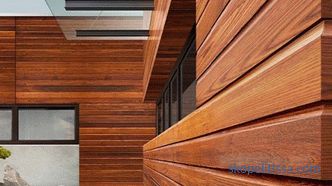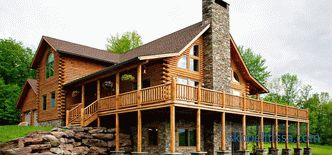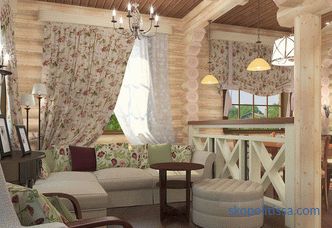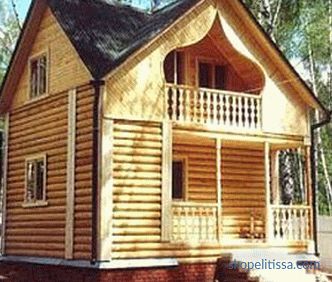Every land owner dreams of a garden season that lasts from April to October and brings several harvests of vegetables, herbs and berries. In itself, this desire is not feasible in most climatic zones of Russia - views of the future harvest in the open field depend on sudden freezing, prolonged spring rain, hail, or pest infestation.
A solution has long been found; Glass greenhouses effectively protect the beds from adverse weather conditions. A stable microclimate, warmth and systematic watering create ideal conditions for the rapid growth of plants.
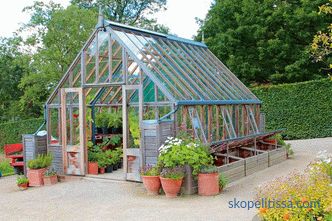
For those who do not want to turn the plot into a solid garden, a house for plants
is suitable. Benefits and disadvantages of glass greenhouses
As a result of the development of technology, new materials have appeared; greenhouses covered with dense air-bubble wrap or cellular polycarbonate are found everywhere. However, traditional glass buildings are still in demand. Glass constructions have enough advantages:
-
Translucency. Maximum when compared with competing materials. Glass retains ultraviolet light, but the plants do not need a tan. For the full development they have enough energy of visible light.
-
Durability. Service life is limited only by the characteristics of the frame.
-
Easy repair and maintenance. A cracked or broken fragment is easy to replace; the surface is cleaned of dirt with a primitive cloth and any detergent.
-
Aesthetics. Glass greenhouses have an attractive appearance and decorate the plot. Glass does not lose transparency when interacting with fertilizers or pesticides.
The glass construction has weaknesses:
-
Fragility. The glass surface cannot always stand under hail. The solution is the use of tempered or laminated (triplex) glass, which, however, will affect the cost of greenhouse construction.
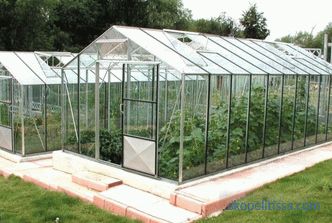
Glass transmits light of the optical and infrared range, which is sufficient for the development of plants
-
Thermal Conductivity. Glass quickly absorbs and releases heat. With a sharp change in ambient temperature, greenhouse plants that are used to comfortable conditions may suffer.
-
Weight. The severity of the glass requires a reliable frame and a strong foundation, otherwise the structure with a large area may collapse.
-
Installation. Requires caution. The finished building should be regularly inspected to identify cracks that have appeared.
Requirements for modern greenhouses made of glass
Modern greenhouse structures:
-
able to maintain a stable level of humidity and temperature;
-
allow the maximum amount of light to pass;
-
weather conditions (frost, gusty wind) withstand loss of quality (corrosion does not form);
-
are easy to operate and economical to maintain.
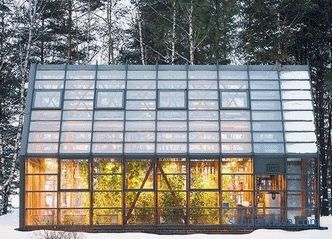
Greenhouse from double-glazed windows - reliable protection against weather vagaries
Greenhouse construction : characteristic of elements
Glass greenhouses have a long history. Winter gardens in which ornamental plants were planted and greenhouses for vegetables were common in England and France more than 250 years ago. Since then, the design has changed little. Its elements are:
Foundation
Foundation extends the service life; it is especially needed for large-scale buildings, glass-pane structures and winter greenhouses. The foundation is designed taking into account the mass of the building, the height of the groundwater, the depth of soil freezing and the climate of the region. An error in the calculations can lead to the deformation of the base and the destruction of the whole structure.
The foundation at ground level is arranged for seasonal constructions. The winter version will require the arrangement of a plinth (for example, from a brick) 30–90 cm high. The best solution is a shallow-tape or monolithic block foundation with a depth of laying 70-80 cm and 30 cm wide.
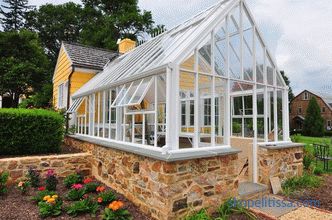
Reliable option - glass greenhouse on stone base
On our website you can find contacts of construction companies that offer installation services for greenhouses and similar turnkey structures . Directly to communicate with representatives, you can visit the exhibition of houses "Low-rise Country".
Frame
The frame can be wooden or metal. Wood is a less resistant material with low thermal conductivity, which helps to maintain the internal microclimate. The metal frame copes better with the load, but loses heat faster.
For the manufacture of the frame, use a metal profile (usually a corner) or, not so often, a galvanized profiled pipe. Elements are connected by welding, screws and bolts.
Walls
Common options include:
-
Stationary Wall. Glass fragments are attached to the aluminum profile frame. The design should provide vents.
-
Sliding. The temperature is adjusted by moving the wall fragments apart. This design is difficult to warm.
-
From plastic profile (single and double chamber windows). Reliable and practical winter version, costly in construction, but economical in heating. The greenhouse from double-glazed windows maintains integrity with a slight deformation of the foundation.
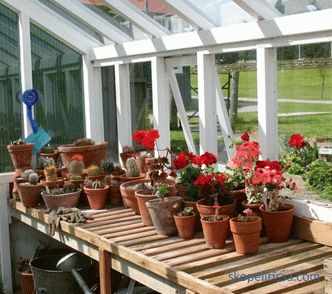
Double-glazed windows help to achieve tightness of the structure
Roof
The number of roof options is limited by the properties of the glass (heavy material, which can be bent using bending technology, at high temperature in a special furnace). In some roofs, vents are arranged.
About the selection criteria for the finished glass greenhouse
Greenhouse facilities can be selected by:
-
Technical parameters. There are vegetable, flower and combined greenhouse facilities.
-
Season of use. Year-round and spring-summer.
-
The type of materials used. Buildings with metal, wooden or polymeric frame.
-
Constructions. Greenhouses under glass are projected straight, domed or have the shape of a pyramid.
-
Technologies. Rack, ground or hydroponic method of growing plants.
Recommendations for choosing
Before you make a choice, you need to analyze the source data:
Choosing a place
In order to to buy a glass greenhouse and later it invariably pleased with fresh vegetables, the place for it is determined on the basis of:
-
Illumination. The future greenhouse should mostly be in the sun, not falling into the thick shadow of trees or buildings. The ideal design will be south-oriented long side.

The orientation of the greenhouse under glass affects the amount of energy received by plants
-
Relief. A flat platform is selected, its dimensions are determined.
-
Wind. It is undesirable to locate a building on a site with a constant draft; the wind will cool the glass surface, reducing the internal temperature.
-
Distances from sources of water and electricity. The closer they are, the less money will be spent on laying communications and organizing heating, watering and lighting.
The size of the plot sets the size of the greenhouse. The next step is the choice of shape, frame and type of glazing.
It may be interesting! In the article on the following link read about winter greenhouses.
Choice of form: popular types of ready-made structures
Greenhouses are built mainly from rectangular elements, since it is unprofitable to bend glass. There are several typical greenhouse projects.
-
With a sloping roof. Classic form, easy to install. An additional bonus is that the snow comes off quickly, without creating dangerous pressure on the glass roof.
-
With a lean-to roof. Such a construction is suitable for small areas and is attached to a capital building, which allows saving on materials. The only negative - the greenhouse must be located on the south side.
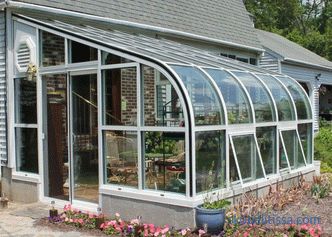
Non-standard option for a small area
-
Dr. Mitlider's greenhouse. The American vegetable grower invented a greenhouse with improved characteristics. The slopes of the roof have different heights; between them, on the south side, the ventilation transom is installed at full length. This design does not create drafts and effectively ventilates the interior. Reinforced frame perfectly resists snow and wind loads.
-
Greenhouse thermos. The best option for arranging a winter greenhouse. The building is buried in the ground, insulated, the main walls are erected. Not a cheap option in construction, which is somewhat leveled by savings on heating.
-
Dome greenhouse. It has the appearance of a geodesic hemisphere, is resistant to loads and ideally distributes natural light. The main difficulty is that such a building requires a large area, otherwise the height may be insufficient for comfortable work. The project requires complex technical calculations.
-
Greenhouse pyramid. Compact and stable option with an entrance on the north side. Sloping walls do not allow to place shelves, but well let the light in the morning and evening hours.
About what gives strength to the greenhouse on the video:
It may be interesting! In the article on the following link, read about how to choose a greenhouse: the best options for giving, sizes, materials.
Choice of a finished glass greenhouse
A few decades ago, greenhouses were knocked together from available sawn timber or welded from metal rods touched by rust. Doors and the whole building covered with foil. Better than them were only school greenhouses, with a wooden frame, foundation and glass, every now and then suffering from young football players.
In the production of modern facilities, high-quality materials and the latest technological developments are used.
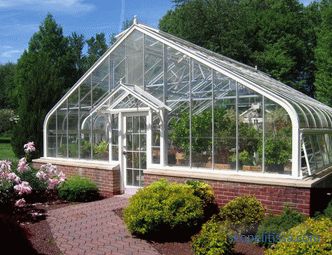
Professionally made greenhouse - long-term construction
Manufacturers offer various options for greenhouses, greenhouses and greenhouses , ranging from 5 to 20 m 2 , suitable for growing flowers, herbs, seedlings for open ground and vegetables. Glass greenhouses from the manufacturer receive a guarantee covering the materials and work.
The customer can choose a ready-made model he likes or order an individual project. Experienced gardeners pay attention to the additional options provided by some companies:
-
Increasing the height of the walls. Promotes better air circulation.
-
Installation of wide doors and low thresholds. Allows you to easily roll the car or make the equipment.
-
Shelving for plants and tools.
About the construction of the greenhouse on the video:
The structures do a good job with wind and snow loads thanks to a robust frame and the use of tempered glass, single or double chamber glass. Installation of a glass greenhouse takes 10-15 days (with a foundation up to 30 days), depending on the selected project.
Construction stages
The construction of glass greenhouses goes through the following stages:
-
After selecting a project, a drawing is drawn up. The type of foundation and materials are also agreed.
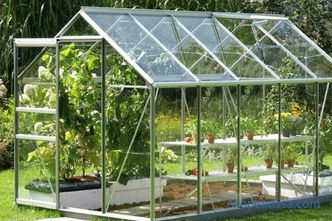
Economical and quick-build turnkey option
-
Specify the dimensions of the structure. Height is the sum of the heights of the basement, wall and roof. The length of the building is the sum of the width of each pillar of the frame and the glazing fragment.
-
The foundation is being arranged. When it dries and gets stronger, a socle is constructed.
-
A frame and a roof are being erected.
-
Glazing of walls and roof ; material is fixed from bottom to top.
-
Doors and window leaves are fastened.
About the tempered glass greenhouse in the video:
Heating of greenhouses made of glass
The advantage of glass constructions - the completely transparent surface - turns into a disadvantage when summer is coming to an end. Glass has a high thermal conductivity; being the boundary between the outer and inner space, it is able to quickly cool the air in the greenhouse.
The larger the structure, the greater the heat loss and energy bills. Therefore, it is more profitable to use greenhouses from glass of a large area not year-round, but seasonally, when the air warms up naturally. The small structure can be heated using:
-
underfloor heating (cable heating);
-
infrared heaters;
-
air circulation oven;
-
heating radiators.
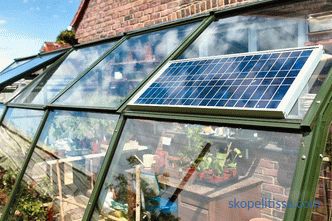
Solar panels - a modern way of heating
It can be interesting! In the article on the following link read about the mini-greenhouse for the garden and at home.
Conclusion
Modern glass greenhouses can be adapted to grow any, even exotic vegetable crops, flowers, berries and greens. Buying a greenhouse from a trusted manufacturer will allow you to use a quality and reliable structure. Greenhouse construction, built in compliance with technological standards, is able to please the hosts with a crop throughout the year.

